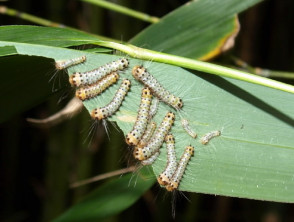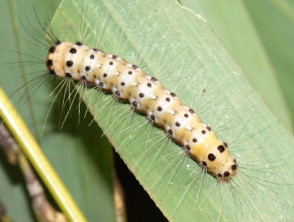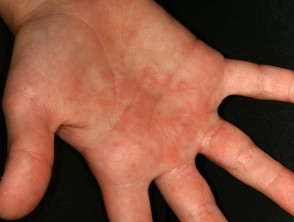Background
Moths and butterflies, and their larvae, caterpillars, belong to the order Lepidoptera. Although there are an estimated 125,000 to 150,000 different species in this order, very few are capable of causing adverse reactions in humans. Caterpillars are responsible for the vast majority of adverse reactions. Adult moths are less commonly implicated, and adult butterflies do not appear to be responsible for any adverse reactions in humans.
Bamboo caterpillars, which caused a rash on a gardener
How do caterpillars and moths injure the skin?
- In order to defend themselves against predators, some caterpillars and moths have developed hairs and/or sharp spines that may be directly irritating or capable of transmitting various toxins.
- In most cases direct contact with the offending species is necessary to provoke a reaction. Occasionally the irritating hairs can be detached and dispersed by winds, causing large outbreaks of reactions in humans. These hairs may also surround cocoons, eggs (transferred from the abdomen of female moths), or other environmental objects. Hairs from some species, such as the oak processionary caterpillar, are stable in the environment for at least one year.
- Some individuals may develop allergic reactions to particular species of caterpillars and moths.
- In very rare cases, spurs on the legs of large moths can penetrate human skin and cause stings, dermatitis, or urticaria.
- Rare species of moths, from the genus Calyptra, are able to bite human skin in order to feed on blood.
How common are skin complaints due to caterpillars and moths?
- Caterpillars and moths are a rare cause of skin disease, particularly in New Zealand.
- Worldwide it is difficult to quantify the number of people affected, as many of the reactions are mild and are not reported to health authorities. Furthermore, in many cases the source of the reaction may not be correctly identified.
- Some species of Lepidoptera become prolific in summer leading to “epidemics” of adverse reactions, for example summertime outbreaks of dermatitis from gypsy moth caterpillars in parts of the United States. Caterpillar and moth exposures are reported more frequently in children.
What are the reactions to caterpillars and moths?
In most cases, adverse reactions to caterpillars and moths are mild and resolve spontaneously. Reactions from contact with caterpillars or moths can be classified based on the predominant symptoms.
| Type of reaction | Clinical features |
|---|---|
| Localised stinging reaction |
|
| Papular urticaria and dermatitis |
|
| Urticarial weals |
|
| Widespread haemorrhage (bleeding) |
|
| Biting moths |
|
| Ophthalmia nodosa |
|
| Oral exposure |
|
| Dendrolimiasis and pararamose |
|
Irritation due to contact with caterpillars
How are reactions to caterpillars and moths diagnosed?
A diagnosis of a reaction to a caterpillar or moth is very difficult to make. The clinical features are non-specific and mimic those of many other insect bites, allergic reactions, and dermatological conditions. Features which may make the diagnosis more likely include:
- A reliable history of exposure in an at-risk geographic location.
- Features consistent with a reaction to a caterpillar or moth such as symptoms on areas of uncovered skin, or occurrence of symptoms in summer months.
Laboratory tests are generally not helpful.
What is the treatment for reactions to caterpillars and moths?
General first aid measures include:
- Remove the caterpillar carefully with forceps or tweezers (bare hands should not be used to remove or squash the insect).
- Sticky tape (especially duct tape) can be used to strip off any remaining hairs from the affected area. Then immediately wash the area with soap and water. Contaminated clothing should be removed and laundered thoroughly.
There is no specific treatment for most caterpillar and moth reactions (the only exception is the widespread haemorrhagic illness due to Lonomia caterpillars, for which there is an antivenom).
- Stinging reactions may be relieved with the application of ice, oral pain relief such as paracetamol, or topical anaesthetics.
- Eczematous reactions can be treated with topical steroids or oral antihistamines, but these treatments are not always effective. Oral or intramuscular steroids have also had mixed success.
- Ophthalmia nodosa and oral exposure require management in hospital to irrigate the area and remove the hairs. Steroids, antihistamines, and surgical removal of granulomas may be necessary.
- Dendrolimiasis can be treated with antihistamines and oral pain relief; surgery may also be required.


